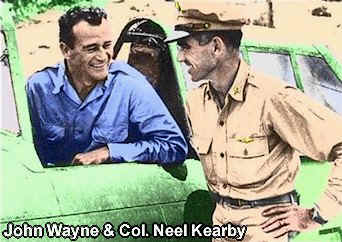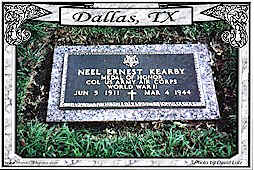|
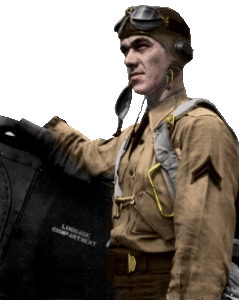
Neel E.
Kearby
Probably the only thing about Neel
Kearby that didn't shout the name "Texan" was his
stature. Unlike the stereo-type: tall, rugged, fearless,
and filled with attitude--Neel stood only 5'9" tall.
The rest of him more than adequately fit the mold.
Born in the rural North Texas town of
Wichita Falls along the Oklahoma border in 1911, Neel was the
son of Dr. and Mrs. J. G. Kearby of Dallas. He grew up
in Arlington, a thriving metropolis sandwiched between Dallas
and Fort Worth, where he first attended high school and later
North Texas Agricultural College, before transferring to the
University of Texas at Austin. He graduated there in
1937 with a degree in Business Administration.
As a boy, Kearby had always been
fascinated with aviation. He earned his first flight by
agreeing to wash a neighbor's private plane. But
Kearby's interest was not only in flight, but in aerial
combat. His boyhood heroes were the pilots of the last
great war, the aces of World War I. He compiled a
personal collection of albums featuring the great aviators who
had inaugurated aerial warfare, and dreamed of someday being
like them. Such dreams compelled him to enlist as a
flying cadet after earning his degree, and he received his
commission as an Army Air Corps aviator in February 1938.
Neel Kearby was an easily likeable man,
reserved on the ground but a tiger in the air. From his early
days of learning to fly in aged AT-6 Army trainers in Texas in
1937, to his tour of duty flying P-39s in Panama during the
first year of World War II, Neel Kearby was known to take his
flying seriously--and competitively. In the cockpit he
was a skilled airman, cool under pressure, and driven to
excel. He was also a keen tactician and a natural leader.
By the time Kearby received orders to depart Panama and assume
command of the new 348th Fighter Group at Westover
Field, Massachusetts, in October 1942, he had risen to the
rank of Major in fewer than four years.
P-47
Thunderbolts
Under Major Kearby the 348th Fighter
Group began training for combat, equipped with the newest
advancement in fighter aircraft, the P-47. Built by
Seversky Aircraft Corporation (later renamed Republic
Aviation), the Thunderbolt was designed specifically
for the air war in Europe as an escort fighter for
high-altitude bombers. For this reason maneuverability
was sacrificed for greater fire-power, heavier armor, greater
durability, and a larger engine. The end-result was a
nearly 7-ton fighter framed within a bulky, barrel-shaped
fuselage. The ungainly airplane was quickly renamed the
"Jug" in derision by other pilots who saw it as ugly
and unsuitable for combat. To make matters worse,
the heavy fighter was very slow taking off and had a very poor
rate of climb . Other pilots joked that if Army
engineers built a runway all the way around the planet, "Republic
(Aviation) would build an airplane that needed every foot of
it (to get airborne.")
Neel Kearby the tactician looked beyond
the engineering nightmare that was the P-47 and found a
flying arsenal. Featuring eight, forward-firing, heavy
50-caliber machineguns, the Thunderbolt was a flying
warhead that could dive with impunity into the most fearsome
enemy formation and emerge unscathed. The P-47 was
designed to withstand a six-ton impact, making it virtually
indestructible. Kearby continued to acquaint himself with the
capabilities of the Thunderbolt and to train his pilots
to take advantage of the aircraft's natural abilities for the
high-altitude air war over Germany. By May his men were ready
for combat in Europe.
Meanwhile, in the Pacific, General
Kenney's P-38 pilots had been writing an impressive resume for
their fast, highly-maneuverable Lockheed Lightnings.
Outnumbered more than two-to-one by the Japanese less than a
year earlier, and supplemented primarily by aging and
battle-damaged P-39s and P-40s, Kenney's fighter pilots now
ruled the skies over eastern New Guinea.
|
Letters
were assigned to aircraft according to their mission
type, followed by numbers denoting their particular
model. Bomber aircraft, for instance, were
preceded by the letter "B", followed by
their model: B-17, B-24, B-25, etc.
During
World War I, fighter aircraft were called
"Pursuit Aircraft", and that designation
remained, thus fighter planes were denoted with the
letter "P" followed by their model: P-38,
P-38, P-40, P-47, etc.
| Other
designations included: |
- "A"
for Attack (Diver Bombers)
- "O"
for Observation Airplanes
- "C"
for Cargo Airplanes
|
- "G"
for Gliders
- "CG"
for Cargo Gliders
- "AT",
"BT", "PT" for Trainers
|
|
The
model number followed by a letter indicates
modifications to a particular model. A
"B-17G", for instance, indicated a
Bomber, model 17, in its
seventh ("G") modification.
Occasionally existing aircraft were modified
for other missions. A P-51 that
had been modified for dive bombing (attack)
missions, was re-designated an A-36.
|
|
The Fifth Air Force had played a key
role in the highly successful campaign to secure the north
side of the Papuan Peninsula and establish air bases east of
Lae, then had crushed the Japanese effort to reinforce Lae
during the Battle of the Bismarck Sea. Kenney's
Fifth Fighter Command was victorious but badly bruised.
In March 1943 General Kenney made his first visit to
Washington, D.C., since taking command of the Fifth Air Force
less than a year earlier. A key part of this trip,
beyond briefing Hap Arnold and the General Staff on the
progress in the Pacific, was to plead for replacement pilots
and new aircraft. The Fifth Air Force had accomplished
what a year earlier was considered impossible, but the toll
left the command worn, torn, bleeding, and struggling to keep
airplanes in the air. The combat toll had been so
extensive it was not unusual for more than half of the
aircraft mounted for a mission to be forced to abort, not
because of enemy fire, but because of mechanical failure.
Kenney quickly learned that among the
top Allied war planners, despite his tremendous success in the
Southwest Pacific, defeating the Japanese was a "war on
the back burner." Most Allied efforts were focused on
defeating the Axis in Europe. This was not a message
Kenney wanted to hear, or a decision he would accept. He
continued to plead for new pilots and aircraft, and the effort
finally paid off. On March 22, less than ten days before
Kenney's return to Port Moresby, Hap Arnold called him
to his office. He advised the Fifth Air Force commander
that he had "squeezed everything dry to give him some
help." That help was to come in the form of:
-
One new heavy bombardment group
-
Two and a half medium bombardment
groups
-
Three new fighter groups--and, "Oh,
one of those groups will have to be a P-47 group. No
one else WANTS them."
Desperate for anything, despite all the
negatives he had heard about the P-47, and ignoring his own
misgivings about the ungainly Jugs, Kenney said he
would gladly take ANYTHING Hap chose to send.
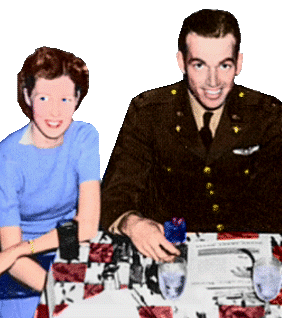 Major
Kearby took a badly-needed break from making his squadrons
ready for combat in Europe on April 3, two days after George
Kenney left Washington to return to his own command.
That seven-day leave gave Kearby the opportunity to spend a
little time with his children and his beautiful wife Virginia,
whom he affectionately called "Ginger." When
he returned to work on April 9, it was to find something
unusual going on. The 348th Fighter Group was
being readied for deployment. Major
Kearby took a badly-needed break from making his squadrons
ready for combat in Europe on April 3, two days after George
Kenney left Washington to return to his own command.
That seven-day leave gave Kearby the opportunity to spend a
little time with his children and his beautiful wife Virginia,
whom he affectionately called "Ginger." When
he returned to work on April 9, it was to find something
unusual going on. The 348th Fighter Group was
being readied for deployment.
Within 30 days the group moved to Camp
Shanks, New York, to begin their final preparations before
leaving for overseas combat. On May 14 both pilots and
planes were boarded on the Army Transport Henry Gibbons.
On May 21 the Henry Gibbons passed through the Panama
Canal, and the men aboard who were headed for war at last knew
what many had begun to suspect, that the 348th Fighter Group
with its P-47 Thunderbolts was not headed for Europe.
They were, in fact, the group no one else wanted that Hap
Arnold had promised General Kenney.
The 348th Fighter Group was headed for
war in the Pacific with their unwanted, untested, and
oft-derided, P-47s Thunderbolts.
|
Lieutenant Colonel Neel Kearby
reported for duty with the Fifth Air Force at Brisbane, Australia, on
June 20. Meanwhile his ground crews and crated P-47s continued
on to their final destination further north at Townsville.
General Kenney recalled meeting Kearby for the first time quite well.
The newly-arrived group commander made a solid impression, not only
for his resume as a seasoned pilot with 2,000 hours of flight time
already on the books, but for his eagerness for combat. From the
moment of that first meeting, something clicked between the two
men, and they became very close friends.
Neel Kearby's boyhood heroes had
been the great aces of World War I, men who admired and hoped to
emulate. Perhaps Kenney saw in Kearby the same fire, ability, and
hunger that had marked one of those men, the pilot even Eddie
Rickenbacker had proclaimed the "the greatest airman of World
War I," the unstoppable Frank Luke. Kenney had flown
combat in that earlier war, shooting down his first German plane on
the same day Luke began his incredible string of aerial victories by
bagging three balloons in a day on September 15, 1918. Kenney
knew well the story of Luke's competitive personality, his daring
braggadocio, and the skill as a pilot that had enabled him to
accomplish what he proclaimed he would do. (In all, Kenney
netted two confirmed kills in World War I, earning the Distinguished
Service Cross for his second aerial victory on October 9.)
Kenney wrote of that
introduction: "Kearby, a short, slight, keen-eyed,
black-haired Texan about thirty-two, looked like money in the bank
to me. About two minutes after he had introduced himself he
wanted to know who had the highest scores for shooting down Jap
aircraft. You felt that he just wanted to know who he had to
beat."
In the summer of 1943 General
Kenney had plenty of seasoned heroes under his command of whom he
could be...and was...justifiably proud. There was Captain George
Welch who had shot down four Japanese airplanes at Pearl Harbor on
December 7, 1941, earning him the Distinguished Service Cross.
Still knocking down enemy airplanes, Welch scored his ninth victory
the day after Kearby reported.
Captain Tom Lynch and First
Lieutenant Richard Bong were tied at eleven victories each, and looked
to be poised for many, many more. The previous December, Eddie
Rickenbacker himself had visited the Fifth Air Force, promising to
match Kenney's proffered case of Scotch to the first airman to beat
the World War I Ace of Aces' unequalled twenty-six aerial
victories. Kenney had no doubt that one of his young pilots
would eventually reach that benchmark, and any one of his three
veteran aces was capable. But Kenney recognized a difference in
the attitude of the young Lieutenant Colonel before him, who had
reported for duty by inquiring who he had to beat for the top spot on
the victory list.
Though Welch, Lynch, and Bong
were each capable of breaking Rickenbacker's record, none of the three
felt pressured to do so. For them, aerial combat was a daily job
of shooting down enemy planes. Theirs' was not a race to the
top. They were simply doing a job to be done, and they were all
three very good at doing their jobs. Neel Kearby, on the other
hand, had a hunger in his eyes. It was a drive perhaps fueled by
his boyhood adoration of the World War I top guns, coupled with
the boyhood dream to emulate, and even exceed, the accomplishments of
his personal heroes. Beyond the hunger that fueled his intensely
competitive spirit, Lieutenant Neel Kearby had both the skill and
tactical prowess to accomplish his goals. Perhaps the only real
difference between Neel Kearby and the great balloon-buster
Frank Luke was that, while Luke's braggadocio turned off his fellow
pilots and relegated him to being a lone-wolf, Kearby was an easily
likable man. No one, least of all General Kenney, took offense
when the 348th Group commander began to proclaim that he intended to
shoot down FIFTY Jap planes.
Of course, before Kenney's newest
would-be ace could get started, General Kenney had to get him
into combat. That, despite Kearby's eagerness, was no small
matter. First and foremost, it would take a month to assemble
the crated P-47s at Townsville. Once assembled, the small fuel
tanks would limit the range of combat operations, necessitating
additional delays until supplemental "wing tanks" could be
manufactured and installed. To further complicate matters, the
veteran pilots of the Fifth Fighter Command weren't all that confident
that the P-47 Thunderbolts were even capable of combat
operations.
| "Everyone
in the 5th Air Force, from (General) Whitehead and (General)
Wurtsmith down, except the kids in the new (348th) group,
decided that the P-47 was no good as a combat plane. Besides
not having enough gas, the rumors said it took too much
runway to get off, it had no maneuverability, it would not
pull out of a dive, the landing gear was weak, and the
engine was unreliable.
"I sent for Kearby
and told him I expected him to sell the P-47 or go back
home. I knew it didn't have enough gas but we would hang
some more on somehow and prove it as a combat plane,
especially as it was the only fighter that (Hap) Arnold
would give me in any quantities for some time.
"I told Kearby that,
regardless of the fact that everyone in the theater was sold
on the P-38, if the P-47 could demonstrate just once that it
could perform comparably I believed that the 'Jug,' as the
kids called it, would be looked upon with more favor.
I told him that Lieutenant
Colonel George Prentice would arrive that afternoon from New
Guinea to take command of the new P-38 group which I had
formed and had started training at our Amberley Field.
He would probably celebrate a little tonight. I told
Neel to keep away from Prentice, go to bed early, and the
first thing in the morning to hop over to Amberley in his
P-47 and challenge Prentice to a mock combat. Neel
Kearby was not only a good pilot but he had several hundred
hours' playing time with a P-47 and could do better with it
than anyone else. Prentice was an excellent P-38
pilot, but for the sake of my sales argument I hoped he
wouldn't be feeling in tiptop form when he accepted Neel's
challenge.
General
George C. Kenney
General Kenney Reports
|
It was this critical situation
that led to the early morning of mock-combat over Amberley where
General Kenney's gamble paid off, resulting in Kearby shooting
down Prentice's P-38 several times. Kenney, for his own
part, was pleased with the outcome and quick to nix any hopes for a
rematch. The single clash between P-38 and P-47 had achieved
its necessary goal. In a rematch, with Prentice at the top of
his form, the results might be reversed.
For the moment it was
sufficient to know that at last the Thunderbolts had been
accepted, even if still dubiously so, as a part of the combat
inventory of the Fifth Air Force. The real test would come
later, when they faced the Japanese in the air. Kenney could
only hope that the P-47 would again prove itself a capable fighter,
despite its many deficiencies.
During the last week of July
Lieutenant Colonel Kearby began moving his fighter squadron to Port
Moresby. Even as they were arriving, Kearby's competition was
growing. On July 26 Lieutenant Bong had his single-best day of
the war, shooting down four enemy planes and earning the
Distinguished Service Cross. Two days later he bagged another,
bringing his score to sixteen.
If Dick Bong wasn't counting,
Neel Kearby certainly was. He saw his competition increase at
the same time he and his men were relegated to generally uneventful
duty at Port Moresby, missions that offered little chance for
combat. Kearby's P-47s were still on a short leash for lack of
supplementary wing tanks. Besides that fact, the
slow-to-takeoff Jugs made them well-suited to the defense of
Port Moresby. Radar provided up to an hour of advance warning
before incoming bogies arrived and, even at their slow climb speed,
an hour was ample to get the Thunderbolts in position to meet
an incoming Zero or bomber.
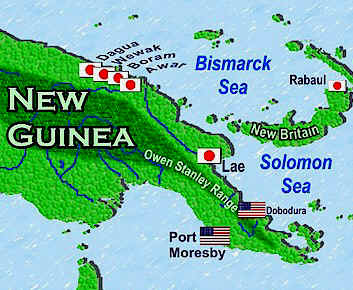
During the first two weeks of
August the Japanese began reinforcing New Guinea by moving hundreds
of fighters into airfields west Lae, on the north coast of the
island, in and around Wewak. Kenney responded at mid-month
with the most sweeping raids since the Battle of the Bismarck Sea.
It was during these missions on August 18 that Major Ralph Cheli was
shot down while piloting his B-25, earning him a posthumous Medal of
Honor.
That same day, a new would-be top
gun with a fire akin that which burned within Neel Kearby, got
his first, and second...and THIRD victory. Two days later the
newly arrived Tommy McGuire became an ace in his P-38.
Dick Bong missed the action
around Wewak in mid-August when the Fifth Fighter Command had some
of its best hunting. The leading Army ace in the Southwest
Pacific had suffered battle damage in a July 28 mission, and his
plane was out for repairs. Kenney promoted Bong to Captain and
sent him to Australia for R & R while his P-38 was being
repaired. In Bong's absence, Tom Lynch took up the slack,
shooting down two enemy on August 20 and bringing his own total to
fourteen. He scored another victory the following day.
While Kenney's Lightnings
had a "field day" in the skies over the Huon Gulf and
around the airfields near Wewak in the latter weeks of August,
Kearby's Thunderbolts continued to fly nondescript
missions--protection patrols at Port Moresby and Dobodura, and
routine convoy escort operations. The one piece of good news
in the month came on August 16 when sixteen P-47s flying close
escort duty for Army transports bound for Marilinan were attacked by
a dozen enemy Oscars. Captain Max Wiecks and Lieutenant
Leonard Leighton each scored a victory, the first for the 348th
Fighter Group.
Lieutenant Leighton was himself
shot down, and was last seen parachuting into the jungle below.
Several months later an Allied patrol found his body, confirming him
as the Group's first combat casualty.
When the month of August ended,
Dick Bong was in Australia, Tom Lynch was two victories behind Bong
with fourteen kills, and the rookie Tommy McGuire's tally was up to
seven. Lieutenant Colonel Neel Kearby, who had yet to prove
the true value of his P-47s despite the Groups two victories, was
still fifty victories shy of the mark he had set for himself.
And for the most part, Kearby and his pilots were still stuck in
convoy escort duty, far from the fertile hunting grounds
around Wewak.
September 4, 1943
First Blood
After the fall of Buna and Gona
in January, Allied attention focused on routing the last Japanese
stronghold at Lae, near the Huon Gulf. Early in the Spring
General Kenney established an airfield at Tsili Tsili, just forty
miles from the large and critical port of Lae. Then, on
September 3, he dispatched twenty-three heavy bombers to unload 84
tons of bombs on Lae's gun defenses while nine strafers followed
with more than 500 fragmentation bombs and 35,00 rounds of
machine-gun fire. It was preparation for the final showdown to
at last capture Lae.
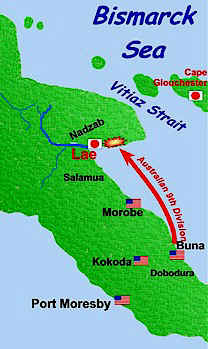 The
following morning two dozen B-24s dropped another 96 tons of bombs
on Lae. Meanwhile Major General Wooten's 9th Australian
Division, departing out of Buna, landed in U.S. Navy LSTs on Hopoi
Beach a short distance east of Lae. The invasion date had been
selected based on suitable weather, cloud cover and fog to keep
enemy planes based on nearby New Britain Island from interfering
with the landing. Unfortunately, that same weather
masked events on the surface of the ocean from the fighter cover
flying just above the haze. When the transports neared the
beach, enemy shore batteries opened up with a withering fire.
Simultaneously, enemy airplanes hidden in the nearby jungle managed
to slip in beneath the haze to attack the landing force. The
following morning two dozen B-24s dropped another 96 tons of bombs
on Lae. Meanwhile Major General Wooten's 9th Australian
Division, departing out of Buna, landed in U.S. Navy LSTs on Hopoi
Beach a short distance east of Lae. The invasion date had been
selected based on suitable weather, cloud cover and fog to keep
enemy planes based on nearby New Britain Island from interfering
with the landing. Unfortunately, that same weather
masked events on the surface of the ocean from the fighter cover
flying just above the haze. When the transports neared the
beach, enemy shore batteries opened up with a withering fire.
Simultaneously, enemy airplanes hidden in the nearby jungle managed
to slip in beneath the haze to attack the landing force.
LST 473 was approaching the
beach with its cargo of Australian infantrymen, tanks and supplies
even as a torrent of deadly shells erupted in the waters around it.
The transport continued its course towards the beach, determined to
brave the maelstrom. Suddenly one of the Japanese dive bombers
came in low and released a torpedo directly into the path of the
landing craft. Seaman First Class Johnnie David Hutchins
glanced quickly to the pilothouse to warn the steersman when, in an
instant, a bomb shattered LST 473. The explosion killed the
steersman and mortally wouded Seaman Hutchins, leaving the barge
nearly dead in the water. LST 473 was helpless and the ship and the
men it carried were doomed by the incoming torpedo.
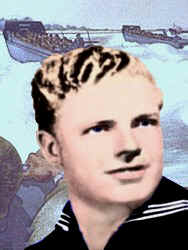 With
only seconds to react, and with the last vestiges of life vanishing
from his battered body, somehow Johnnie Hutchins managed to stagger
to the wheel and turn the ship clear of the torpedo's path.
Then he died, still clinging to the wheel. With
only seconds to react, and with the last vestiges of life vanishing
from his battered body, somehow Johnnie Hutchins managed to stagger
to the wheel and turn the ship clear of the torpedo's path.
Then he died, still clinging to the wheel.
Around him combat-hardened
Australian soldiers who had seen the act were awed by the sheer
resolve and determination they had witnessed. They could not
forget the smiling, blond, 21-year-old sailor from Texas who had
sacrificed his last ounce of ebbing strength to save their lives.
One year later at the Sam Houston Coliseum in Houston, Texas, Rear
Admiral A. C. Bennett presented Johnnie Hutchin's well-deserved
Medal of Honor to his mother.
Despite the hail of enemy fire
from the beach, General Wooten's Rats of Tobruk, so-named for
their own heroic stand a few years earlier in North Africa, landed
together with their tanks and supplies. Before noon the
transport convoy began the return trip to Buna, save for Johnnie
Hutchins' and one other transport so damaged that it would only get
as far as the port at Morobe.
The returning convoy was faced
with new dangers when the afternoon sun burned off the haze,
exposing the ships to enemy flights out of New Britain. At the
airfield at Dobodura near Buna, Lieutenant Colonel Neel Kearby was
unaware that enemy pilots had killed a fellow Texan, but he was well
aware that a fight was brewing. Word reached Dobodura that
enemy aircraft had been sighted moving into the Morobe, Salamua, and
Finchhafen areas, which were near the invasion site at Hopoi Beach.
It was the anticipated enemy response to the landing of Australian
troops on the doorstep of their fortress at Lae.
Kearby's Thunderbolts
began taking off around two o'clock in the afternoon, Yellow Flight
from the 342d Squadron, followed by seven more airplanes of Blue and
Green Flights. The last flight of twenty P-47s was led by the
Group commander himself.
Half-an-hour later Kearby's
formation of four fighters were fourteen miles south of Hopoi Beach,
cruising easily at 25,000 feet, when Neel saw what appeared to be
two fighters and a flying boat flying close-formation miles below.
At that distance it was impossible to identify the bogeys and Kearby
knew if he dove, he would lose precious altitude that would be
difficult to recover if the dark blips beyond turned out to be
American. Kearby noted the signs of bomber damage around
Morobe and several fires in the water near Cape Ward Hunt, and
decided the possibility that the unidentified airplanes were enemy
made it worth the risk. With his wing man trailing, he nosed
into a steep dive at more than 400 miles per hour, closing the gap
in less than a minute.
At 2,000 feet Kearby and
Lieutenant George Orr, his wingman, closed to within three-hundred
yards behind and to the left of the three aircraft. The large
flying boat in the center was a Betty bomber, protected by a
Zero and an Oscar close on each wing. The red orbs of the
rising sun confirmed their identity as Japanese.
Adrenaline filled every fiber
of the would-be super-ace at the prospect of his first combat.
Perhaps it was buck fever, it was doubtless NOT by design,
that rather than making a nearly sure-shot at one plane, Neel Kearby
unleashing his eight 50-caliber machineguns on two enemy at once.
Even before Lieutenant Orr could trigger his own guns, the wing-man
watched in amazement as the Betty bomber exploded. One
wing ripped away from one of the escorting fighters, causing it to
also plunge into the sea below. Kearby knew he had been
lucky--his first victory had been a double-punch. Chalk one up
for the highly-touted increased firepower of the P-47. There
could be no more doubts.
The P-47s zipped past the
flaming, falling debris that had been two enemy planes before they
could sight on the third fighter. Struggling against the
inertia of their diving seven-ton Thunderbolts, Kearby and
Orr banked and tried to pursue the now vanishing Oscar. Kearby
tried to line up for a third kill, but the Japanese pilot executed a
nimble climb, leaving Kearby's sights filled only with blue sky and
white clouds.
Nearly thirty enemy aircraft
were destroyed on September 4, six by the anti-aircraft guns in the
convoy, twenty-one of them by General Kenney's P-38s. Neel
Kearby scored the only victories for the 348th squadron. Kearbyy
also realized that his over-eagerness had disrupted what could have
been a near-perfect attack, one that would have netted all three
enemy planes.
The keen tactician mentally
noted his mistakes, which could not take away from his celebratory
mood upon returning to Ward's Drome. Not only was he at last
in the race for Top Gun, he had demonstrated the soundness of
a tactic he had preached to his pilots since they received the first
P-47s back in the states. Despite its weight, its clumsiness
at low altitudes, and its slow rate of climb, the Thunderbolt
could be deadly when tactically deployed. Kearby would leave
it to lighter, more nimble fighters to dog-fight at low altitudes.
Proper use of the Thunderbolt meant free-roving flights at
high altitude, where they were designed to fly, and where they could
track enemy formations unseen. When the moment came for combat
the Thunderbolt's unequalled diving speed would put its guns
within range of destroying that formation, long before the enemy
even knew American pilots had spotted them.
The battle for Lae was the
focus of the Fifth Air Force efforts for nearly two weeks. On
September 5 Kenney's bombers continued to pound enemy positions in
support of the ground operations. This further including dropping
Australian paratroopers into Nadzab west of Lae. For the
Australians, it was their first jump ever. After a last-minute
decision to insert them by air, their pre-jump training had
consisted of nothing more than brief instructions on how to pull the
ripcord that deployed the chutes. The operation was
surprisingly successful and by nightfall Nadzab was in Allied hands.
The following day air
operations continued with Fifth Air Force C-47 transports flying
General Vasey's 7th Australian Division into Nadzab. To
protect the troop movement, bombers continued to pound enemy
fortifications around Lae, and fighters did their best to keep enemy
aircraft out of the battle. Dick Bong, recently returned from
Australia, claimed two more enemy aircraft shot down. Neither
was ever confirmed or added to his score--which is ironic. If
Dick Bong claimed he shot something down, it was no exaggeration.
The intrepid Captain had a reputation, not of padding his score, but
of frequently giving credit for his own victories to other pilots.
Unfortunately, on returning to Marilinan airfield, Bong made a
difficult crash landing. Though he survived uninjured, he was
again temporarily out of action.
The ground combat to take Lae
continued unabated and with great success by the determined
Australians in the week following the landings at Hopoi Beach and
Nadzab. Air operations, on the other hand, were greatly
hampered by a week of poor weather. Towards mid-month the
weather began to clear slightly, and increased air combat followed.
Neel Kearby's double victory on September 4 brought to four the
total number of aerial victories for his fighter group. On
September 13 Major Bill Banks and Lieutenant Larry O'Neill each
scored while flying routine transport cover, upping the P-47 tally
to six.
The following day, while
leading a similar mission at 20,000 feet near Nadzab, an
unidentified aircraft was spotted about 9:45 a.m. above and to the
right of Kearby's formation. When the bogey saw the American
planes it began a desperate race for the clouds, a quick indication
to Kearby that it was enemy.
Kearby's P-47s were now
operating with disposable drop tanks to extend their range.
These supplemental fuel cells were normally released only before
combat, at which time they were lost forever. Realizing he was
still short of drop tanks, Kearby ordered his other pilots not to
drop their tanks. Instead, he would drop his own and pursue
the enemy alone. It was too late. With an eagerness for
combat that Kearby could now identify with, six of his seven pilots
had already dropped their tanks to follow their commander into
combat. (Kearby later learned that the seventh pilot would
have dropped his as well, but the mechanism jammed.)
Kearby got there first, closing
in at three-hundred yards on what he could now identify as a
Japanese Dinah. A single, three-second burst from eight
machineguns sent the enemy plane down in flames, and Kearby had
upped his score to three. It would be his last for the month,
indeed the last for a dry spell lasting nearly 30 days.
Meanwhile, in that first full month of combat, his Thunderbolt
fighter group had claimed eleven confirmed victories, at least
another dozen probable but unconfirmed, and with the loss of only
two of their own.
On the day Neel Kearby got his
third victory, Tom Lynch became a triple-ace. The following
day, September 16, while the Australian forces marched victoriously
into Lae, Lynch scored again. He was now tied at sixteen with
Dick Bong, who was returning to action.
Before Bong pulled back into
the lead with his seventeenth victory on October 2, Tommy McGuire
had upped his own score to seven, with two victories on September
28. Despite the dry spell for all of them over the following
week, things were shaping up to erase any lingering doubts about the
combat prowess of the P-47 Thunderbolt.
|
It was late June, 1943, and a lone American P-38 Lightening circled leisurely over Amberley Field near Townsville, Australia. In the cockpit was Lieutenant Colonel George Prentice, a solid combat veteran with two aerial victories, including one shoot-down four months earlier during the critical Battle of the Bismarck Sea.
Then, seemingly out of nowhere, a second fighter appeared. Incredibly the invader was diving from ABOVE...instantly and with deadly precision, in a lethal attack on Colonel Prentice's P-38. Powered by a single, 2,400-horse-power radial engine and with the added inertia of a seven-ton monster of a fighter plane, the attacker screamed in for the kill at more than 400 miles per hour. Four large machineguns were mounted on each wing, every one of them ready to fill the doomed P-38 with hundreds of 50-caliber rounds in less than a minute. Looking out his cockpit window, Lieutenant Colonel Prentice cursed his over-confidence, winged over, and tried to shake the barrel-shaped behemoth off his tail. It was too late--the attacking enemy couldn't be shaken.


 Major
Kearby took a badly-needed break from making his squadrons
ready for combat in Europe on April 3, two days after George
Kenney left Washington to return to his own command.
That seven-day leave gave Kearby the opportunity to spend a
little time with his children and his beautiful wife Virginia,
whom he affectionately called "Ginger." When
he returned to work on April 9, it was to find something
unusual going on. The 348th Fighter Group was
being readied for deployment.
Major
Kearby took a badly-needed break from making his squadrons
ready for combat in Europe on April 3, two days after George
Kenney left Washington to return to his own command.
That seven-day leave gave Kearby the opportunity to spend a
little time with his children and his beautiful wife Virginia,
whom he affectionately called "Ginger." When
he returned to work on April 9, it was to find something
unusual going on. The 348th Fighter Group was
being readied for deployment.
 The
following morning two dozen B-24s dropped another 96 tons of bombs
on Lae. Meanwhile Major General Wooten's 9th Australian
Division, departing out of Buna, landed in U.S. Navy LSTs on Hopoi
Beach a short distance east of Lae. The invasion date had been
selected based on suitable weather, cloud cover and fog to keep
enemy planes based on nearby New Britain Island from interfering
with the landing. Unfortunately, that same weather
masked events on the surface of the ocean from the fighter cover
flying just above the haze. When the transports neared the
beach, enemy shore batteries opened up with a withering fire.
Simultaneously, enemy airplanes hidden in the nearby jungle managed
to slip in beneath the haze to attack the landing force.
The
following morning two dozen B-24s dropped another 96 tons of bombs
on Lae. Meanwhile Major General Wooten's 9th Australian
Division, departing out of Buna, landed in U.S. Navy LSTs on Hopoi
Beach a short distance east of Lae. The invasion date had been
selected based on suitable weather, cloud cover and fog to keep
enemy planes based on nearby New Britain Island from interfering
with the landing. Unfortunately, that same weather
masked events on the surface of the ocean from the fighter cover
flying just above the haze. When the transports neared the
beach, enemy shore batteries opened up with a withering fire.
Simultaneously, enemy airplanes hidden in the nearby jungle managed
to slip in beneath the haze to attack the landing force. With
only seconds to react, and with the last vestiges of life vanishing
from his battered body, somehow Johnnie Hutchins managed to stagger
to the wheel and turn the ship clear of the torpedo's path.
Then he died, still clinging to the wheel.
With
only seconds to react, and with the last vestiges of life vanishing
from his battered body, somehow Johnnie Hutchins managed to stagger
to the wheel and turn the ship clear of the torpedo's path.
Then he died, still clinging to the wheel.
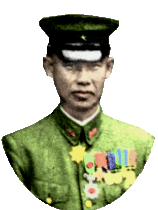 In
fact the enemy had ALREADY risen to the bait. Lieutenant Colonel Tamiya
Teranishi, commander of the Japanese 14th Fighter/Bomber group, was visiting
Wewak when radar picked up the incoming Thunderbolts from fifty miles
out. He ordered numerous fighters airborne from their fields in the
vicinity, then climbed in an Oscar himself and took off to lead the
intercepting force. Once rendezvoused with the other fighters he had
called into action, his flight would number more than two dozen armed
fighters: nimble Oscars and deadly Tonys.
In
fact the enemy had ALREADY risen to the bait. Lieutenant Colonel Tamiya
Teranishi, commander of the Japanese 14th Fighter/Bomber group, was visiting
Wewak when radar picked up the incoming Thunderbolts from fifty miles
out. He ordered numerous fighters airborne from their fields in the
vicinity, then climbed in an Oscar himself and took off to lead the
intercepting force. Once rendezvoused with the other fighters he had
called into action, his flight would number more than two dozen armed
fighters: nimble Oscars and deadly Tonys.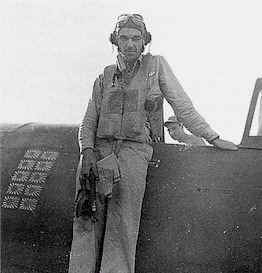
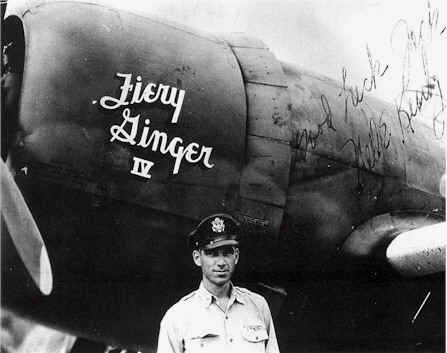
 At
the same time General Kenney submitted his report verifying Kearby's
six single-day victories in support of a recommendation for the Medal
of Honor, Kearby was promoted to Colonel. In the weeks that
followed Neel pushed himself, not only to try and catch the elusive
Dick Bong, but to achieve his personal goal of fifty aerial victories.
Five days after his big day over Wewak, Kearby upped his score to ten.
He brought it to a dozen with a double victory on October 19.
At
the same time General Kenney submitted his report verifying Kearby's
six single-day victories in support of a recommendation for the Medal
of Honor, Kearby was promoted to Colonel. In the weeks that
followed Neel pushed himself, not only to try and catch the elusive
Dick Bong, but to achieve his personal goal of fifty aerial victories.
Five days after his big day over Wewak, Kearby upped his score to ten.
He brought it to a dozen with a double victory on October 19. 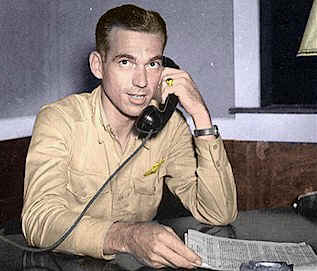 General
Kenney did attempt to slow Kearby down, fearful that the intense drive
that pushed the young pilot nearly beyond reason would ultimately
become his downfall. More and more he tried to keep Colonel
Kearby occupied with administrative duties, but there was no keeping
the man who wanted to be the greatest fighter pilot all time out of
the air. Kenney noted the difference between the personalities
of Kearby and Bong when he wrote his memoirs after the war.
General
Kenney did attempt to slow Kearby down, fearful that the intense drive
that pushed the young pilot nearly beyond reason would ultimately
become his downfall. More and more he tried to keep Colonel
Kearby occupied with administrative duties, but there was no keeping
the man who wanted to be the greatest fighter pilot all time out of
the air. Kenney noted the difference between the personalities
of Kearby and Bong when he wrote his memoirs after the war.